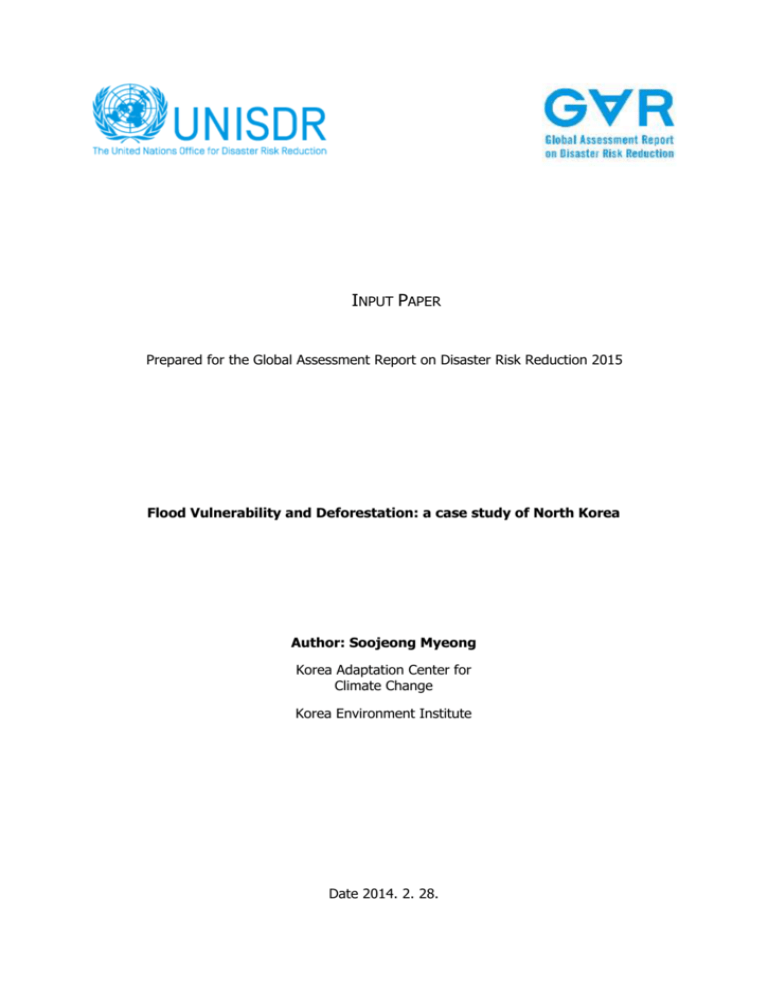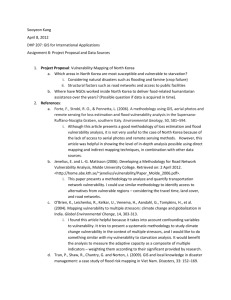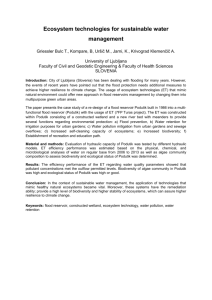Myeong, S. 2014. Flood Vulnerability and
advertisement

INPUT PAPER Prepared for the Global Assessment Report on Disaster Risk Reduction 2015 Flood Vulnerability and Deforestation: a case study of North Korea Author: Soojeong Myeong Korea Adaptation Center for Climate Change Korea Environment Institute Date 2014. 2. 28. Table of Contents Introduction .................................................................................................................. 3 Introduction ............................................................................................................... 3 Flood Vulnerability and Deforestation of North Korea ......................................................... 3 Flood Vulnerability and Natural Disasters....................................................................... 3 Deforestation in North Korea ........................................................................................ 5 Relationship between Flood and Deforestation ............................................................... 5 Discussion and Conclusion ........................................................................................... 6 References..................................................................................................................... 7 2 Introduction Forest ecosystems provide humans with diverse ecosystem services: water and air purification, food provision, ground water recharging, recreation services, biodiversity conservation, atmospheric carbon storing through photosynthesis, buffering functions against natural disaster, etc. The study on economics of ecosystem (Costanza et al., 1997; TEEB, 2010) showed the importance of natural ecosystems for the well-beings of humans in various ways. One of the primary concerns in climate change is dealing with natural disasters and extreme events such as flash flood and severe drought. IPCC (2012) stated that a changing climate leads to changes in the frequency, intensity, spatial extent, duration, and timing of extreme weather and climate events, and can result in unprecedented extreme weather and climate events; it is likely that the frequency of heavy precipitation or the proportion of total rainfall from heavy falls will increase in the 21st century over many areas of the globe. Therefore, maximizing the ecosystem service of forest would greatly help to mitigate the climate related natural disasters and promote climate change adaptation. In addition, it would also help to uptake atmospheric carbon through photosynthesis process, thereby reducing the concentration of atmospheric carbon and thus greatly contributing to climate change mitigation. North Korea has been experiencing severe losses and damages from natural disasters, especially from floods for many years (Myeong et al., 2009, 2013). The major cause for the occurrence of flood could be the impact of climate change. However, deforestation activities can be one of the main culprits for flood damages. Since deforestation not only decreases the amount of carbon stored in the forest but also reduces ecosystem’s natural buffering function against flood. This study aims to examine the relationship between flood damage and forest cover in order to provide an insight for both climate change adaptation and mitigation. Flood Vulnerability and Deforestation of North Korea This section introduces flood vulnerability and natural disasters, and deforestation in North Korea first and examines the relationship between flood and deforestation. Flood Vulnerability and Natural Disasters North Korea has been reported to be damaged by natural disasters almost every year (Myeong et al., 2013). The types of natural disasters in North Korea are flood (both general flood and flash flood), storm, drought, storm surge and coastal flood, cyclone, and bacteria infectious diseases. North Korea is especially vulnerable to flood disaster among diverse types of natural disaster. An analysis of natural disaster data (1987-2013) from EM-DAT shows that 93% of the people killed from natural disasters were victims of floods and that 77% of the affected people were flood-related victims (Image 1). 3 Image 1 : The Number of People Killed (left) and the Number of People Affected by Natural Disasters in North Korea. (Data from EM-DAT). Flood is certainly the major disaster type in North Korea. The number of reported disasters The has increased since the 1980s. The number of people affected by floods peaked in the 1990s showed some decrease in the 2000s. However, the number of people killed by floods has The data continuously increased since the 1980s (Image 2). Image 2 : The Number of People Killed (left) and the Number of People Affected by Natural Disasters in North Korea. (Data from EM-DAT). 4 The cause for the casualties could be climate change and also land use change. Climate change is occurring faster in North Korea compared to the trend of other areas (Korea Meteorological Agency, 2012); especially the mean temperature rise of North Korea is fast. The precipitation pattern of North Korea has been changed; mostly the intensity of rainfall has increased. Consequently, North Korea is becoming more exposed to flood and drought risks. To make the damages worse, North Korea has cleared forests since the 1980s. With these two causes, North Korea became more and more vulnerable to natural disasters. Deforestation in North Korea North Korea has been suffering from food and energy shortages since the 1980s. To overcome these shortages, she has cleared forests for logging to provide energy and also for expanding the agricultural land. However, though the forested area has been diminished greatly, she could not successfully cultivate crops in the cleared areas. Crops could not grow well, and then these areas without vegetation became directly exposed to rainfalls. In addition, as North Korea is within the typical monsoon climate zone, most of the yearly precipitation falls during the summer season. Furthermore, she has considerably hilly terrains all over the country, which makes North Korea more vulnerable to flood. If the forest ecosystem can provide ecosystem services, it can reduce flood vulnerability somehow. However, the forest area of North Korea is continuously decreased (see Table 1). Forest Barren Cropland 80s 75.38 0.81 17.15 90s 71.48 1.48 18.84 00s 68.42 1.00 24.89 Table 1 : Changes of Forest and Barren Areas and Cropland of North Korea (%). With deforestation, North Korea is losing the nature’s buffering function against flood. Consequently, North Korea has serious damages when it rains heavily. Therefore, it is urgent to restore the forest ecosystem to maximize ecosystem services. Though reforestation efforts have been made, it is difficult to plant and grow trees because the top soil on the cleared areas has been lost greatly. Relationship between Flood and Deforestation It can be said that deforestation certainly brings forth a negative impact on flood vulnerability because deforestation removes ecosystem services of the forest. To examine the relationship between flood and deforestation, regression analysis was applied to flood vulnerability and deforested area. The flood vulnerability used for this analysis was estimated based on topography, meteorology, hydrology, land use, soil and hazard history including 5 the property damage and return period, and population (Myeong and Hong, 2009). The flood vulnerability map has 5 levels of vulnerability from 1 - 5. Barren areas with no vegetation based on Landsat TM imagery were considered as deforested areas (Myeong et al, 2013). The average vulnerability of each province and special cities over the country was compared with the percentage of the barren area of that unit. It was found that the relationship between vulnerability and deforested area was linear; flood vulnerability increased as deforested area increased (Image 3). Image 3: The relationship between flood vulnerability and deforested area. TheThe r-square of the vulnerability and deforested area was 0.59, which means that there is a positive relationship between flood vulnerability and deforestation. The data Discussion and Conclusion Forests provide key ecosystem services of nature’s buffering functions against natural disasters. North Korea has cleared forested areas near where people live for the purpose of logging for fuel and also for agriculture. Due to the terrain, rain patterns and cultivation characteristics, North Korea could not increase food productivity in spite of the sacrifice of forested areas. Instead, the country is losing top soil whenever it rains, and is deteriorating flood vulnerability. Without top soil, it is difficult to restore the forest ecosystem through reforestation. Without restoring the damaged forest ecosystem, flood vulnerability will become greater. Then, she will lose top soil more, and it will be a vicious cycle of deforestation and natural disasters. Food and energy are two main requirements for humans. In many developing countries where people lack food security and energy provision, logging is one of the most common approaches to overcoming the difficulties. Therefore, developing countries are losing forested areas, which in turn lead to more exposures to natural disasters. The case 6 examined in this study with North Korea is not an unusual one but a typical issue related with flood in many developing countries. North Korea will suffer from floods if timely adaptation is not achieved. With climate change, the potential of climate related disasters will be severer in the future. The analysis of EMDAT showed that the trend of natural disasters and casualty is increasing continuously. It is difficult to conclude about the trend of climate related casualties of North Korea based only on this analysis because it is possible that not all the casualties from natural disasters were reported in the past. However, it is generally known that the intensity and frequency of natural disasters are increasing. Therefore, climate change adaptation should become a prioritized activity in North Korea. The analysis of this study showed a linear relationship between flood vulnerability and deforestation. A way to prevent flood damages, maximizing ecosystem services from the forest, is desired. Since the forest is the nature’s storage of carbon dioxide, which is the major greenhouse gas, preventing deforestation and restoring the damaged forest ecosystem is a desirable and recommendable approach to climate change mitigation. To pursue climate change adaptation and mitigation, reforestation efforts should be made in North Korea. If she succeeds in reforestation and reducing flood vulnerability, it will be a good example applicable to other developing countries. Global efforts for this approach should needs to be made. References Costanza, R., d’Arge, R., de Groot, R., Farber S., Grasoon, M. Hannon, B., Limburg, K., Naeem, S., O’Neill, R. V., Paruelo, J., Raskin, R. G., Sutton, P. 1997. The value of the world’s ecosystem services and natural capital. Nature. 387: 253-260. IPCC. 2012. Managing the risks of extreme events and disasters to advance climate change adaptation. A special report of working groups I and II of the Intergovernmental Panel on Climate Change. [Field, C.B., V. Barros, T.F. Stocker, D. Qin, D.J. Dokken, K.L. Ebi, M.D. Mastrandrea, K.J. Mach, G.-K. Plattner, S.K. Allen, M. Tignor, and P.M. Midgely (eds.)]. Cambridge University Press, Cambridge, UK, and New York, NY, USA. Korea Meteorological Agency. 2012. A Report on Climate Change Projection of the Korean Peninsula. Korea Meteorological Agency, Seoul, Korea. Myeong, S. et al. 2013. A study on constructing a cooperative system for South and North Koreas to Counteract climate change in the Korean Peninsula Ⅲ. Korea Environment Institute, Seoul, Korea. Myeong, S. and Hong, H. 2009. Developing flood vulnerability map for North Korea. ASPRS 2009 Annual Conference. Baltimore, Maryland. TEEB. 2010. The Economics of ecosystems and biodiversity: mainstreaming the economics of nature: a synthesis of the approach, conclusions and recommendations of TEEB. 7 EM-DAT. http://www.emdat.be/. 8








